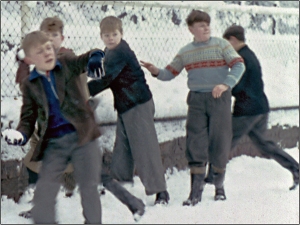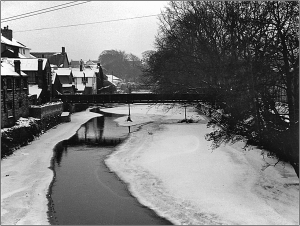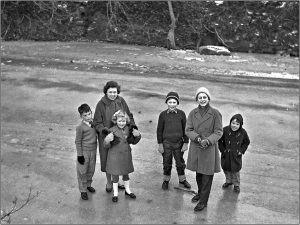It’s hard to believe really that it was fifty years ago that the River Ogmore froze. The winter colds of January 1963 plunged the temperatures to below freezing for weeks on end, commencing with snow which hung around for months; the ice took a grip on everything, milk bottles bursting on the doorstep, frozen pipes, icicles everywhere, even the fast-flowing river which ran through our town. January 1963 was the coldest month of the 20th Century and much of England and Wales was snow covered throughout that month with freezing fog also a severe hazard for most of the country.
 In the first couple of days of 1963 there was a general excitement with the arrival of the snow, lots of it, but not so much that everything ground to a standstill, all the kids soon got stuck into some snow fun, but this initial excitement soon palled as the temperatures plummeted over the next day or so. The schools remained open and we trudged across the snow in biting winds to get there, relieved when we were able to get in out of the cold. Weeks went by, often more snow overnight, and still the low, low temperatures. We were fortunate in our house as the previous summer my father had installed a gravity-fed anthracite boiler which partially heated some of the downstairs and also the hot water storage cylinder in the bathroom, and this kept some of the house at least a little warmer. The bathroom was still a bit of a challenge though as only minimal warmth was radiating from the cylinder inside the cupboard. Bedtime was a bit of a chore too, frost inside the windows even though we had a bit of heating downstairs, our beds piled high with blankets and eiderdowns and when it became even colder, our overcoats on top of that lot as well; once in between the sheets and with a hot water bottle we were soon cosy and warm.
In the first couple of days of 1963 there was a general excitement with the arrival of the snow, lots of it, but not so much that everything ground to a standstill, all the kids soon got stuck into some snow fun, but this initial excitement soon palled as the temperatures plummeted over the next day or so. The schools remained open and we trudged across the snow in biting winds to get there, relieved when we were able to get in out of the cold. Weeks went by, often more snow overnight, and still the low, low temperatures. We were fortunate in our house as the previous summer my father had installed a gravity-fed anthracite boiler which partially heated some of the downstairs and also the hot water storage cylinder in the bathroom, and this kept some of the house at least a little warmer. The bathroom was still a bit of a challenge though as only minimal warmth was radiating from the cylinder inside the cupboard. Bedtime was a bit of a chore too, frost inside the windows even though we had a bit of heating downstairs, our beds piled high with blankets and eiderdowns and when it became even colder, our overcoats on top of that lot as well; once in between the sheets and with a hot water bottle we were soon cosy and warm.
Someone had said the sea was freezing over, so one day off we went in the car to have a look; my memory of this is rather vague but seem to recall a thin layer of cracked ice and the sea had a glassy look but it wasn’t really solid, unlike other areas of the country such as on the east coast of England where you could safely walk on it and I believe I was a little disappointed.
 Through Bridgend ran the River Ogmore and before long the slower and deeper stretches began to freeze; soon after even the faster flowing sections crusted over from the banks until only a small section in the very centre remained ice-free as shown here. This photograph is taken from the old stone bridge, the yet-to-be-built council offices will one day be behind the trees on the right of the picture. Gradually too, this centre section froze and the river could be heard continuing to gurgle beneath the ice. Before long the adventurous were beginning to skate about on the more solid sections and soon everyone had to have a go just to say they’d walked, skated or played games on the river.
Through Bridgend ran the River Ogmore and before long the slower and deeper stretches began to freeze; soon after even the faster flowing sections crusted over from the banks until only a small section in the very centre remained ice-free as shown here. This photograph is taken from the old stone bridge, the yet-to-be-built council offices will one day be behind the trees on the right of the picture. Gradually too, this centre section froze and the river could be heard continuing to gurgle beneath the ice. Before long the adventurous were beginning to skate about on the more solid sections and soon everyone had to have a go just to say they’d walked, skated or played games on the river.
 Better than that though, my father actually captured us on camera on the frozen river. Here we all are just downstream of the “White Bridge” in Newbridge Fields and this is just one of eight photographs he took that day of the ice. I’m in the foreground (second from right) with brother Geoff just behind, my Mother and sister Sheila are next, and on the extremities are Kevin (left) and Alan, the two boys who lived next door. We’re all wearing our ordinary shoes as in this sort of temperature your feet froze in wellington boots even with two or more pairs of socks; I’m also wearing my school raincoat and probably my school trousers as well, all topped off with a bright yellow bobble hat!
Better than that though, my father actually captured us on camera on the frozen river. Here we all are just downstream of the “White Bridge” in Newbridge Fields and this is just one of eight photographs he took that day of the ice. I’m in the foreground (second from right) with brother Geoff just behind, my Mother and sister Sheila are next, and on the extremities are Kevin (left) and Alan, the two boys who lived next door. We’re all wearing our ordinary shoes as in this sort of temperature your feet froze in wellington boots even with two or more pairs of socks; I’m also wearing my school raincoat and probably my school trousers as well, all topped off with a bright yellow bobble hat!
* * * * * * * * * * * * * * * * * * * * * * *
Thanks to Philip Howard for the use of the first photograph to illustrate this story. The second photograph is from the John Lee Collection in my possession and the third is from my own collection of family photographs.

My children refuse to believe me when I tell them that ice used to form on the inside of the bedroom window. The only frozen sea that I have ever seen was in Jurmala in Latvia.
As part of my promotion of this blog I post a link on my facebook account; there was a flurry of comments yesterday from a number of my friends who all made similar comments about ice inside the windows!
Pingback: Where have all our winter’s gone? « opobs
When I was living down in Portsmouth in 1985, it snowed in January or February of that year. It wasn’t too heavy a snowfall and lay for what seems in memory only a few days. (Perhaps a week at the most.) To a Scotsman well-experienced in living in a cold climate, it didn’t seem too bad and was only a minor inconvenience. However, to hear the locals go on about it, you’d have thought it was a disaster of epic proportions. “Worse snow we’ve had since 1963,” thet would moan. I imagined they were plucking an approximation from memory as to what year it actually was, but around 20 years later, the date was confirmed when I heard someone on a radio show talk about the severe weather of that specific year. Now your own post has confirmed beyond any doubt. I actually remember 1963 in Scotland and recall sliding down a nearby hill on my sledge, but I don’t recollect that it was a particulary severe winter, either at the start or the end of the year. Having said that, I was only about 4 or 5, so I would have been oblivious to anything beyond making snowmen, throwing snowballs, and sledging. Happy days.
There was a prog on the Beeb the other evening about the 63 snow and I must admit to not remembering anything about the severe conditions we were told occurred. Thankfully the photos taken of us on the river were not a figment of the imagination!
Oops! I meant ‘worst’, not ‘worse’.
Pingback: I really must try harder | opobs